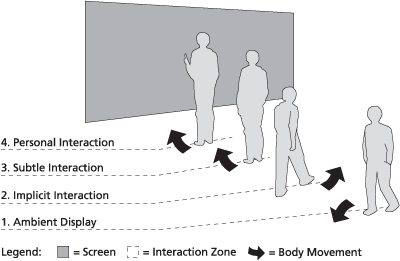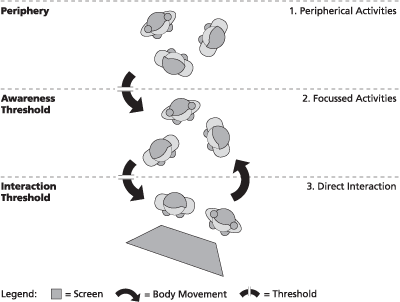Friday, April 17, 2009
Daniel Michelis: Interactive Displays in Public Spaces Blog
Daniel Michelis recently completed his Ph.D. dissertation on a topic that is dear to my heart. Information about his research can be found on his Interactive Displays in Public Spaces blog.
Here are links to a few of his posts:
Interactive Displays: Perception, Awareness, and Interaction
Evaluating Interaction with Display Applications in Public Space
I especially like the diagrams Daniel uses to depict zones of interaction:
Figure 3: Four-phase Model
(Source: Daniel Michelis (2009), according to: Vogel and Balakrishnan, 2004)
(Author: Daniel Michelis, Institute for Media and Communications Management, University of St. Gallen)


Figure 1: Perception and Usage of Interactive Displays
(Source: Daniel Michelis (2009), according to: Brignull & Rogers, 2003)
Friday, April 10, 2009
Sprint's Welcome to the Now Network: "What's Happening Now" Infographic-like Commercial
I saw this commercial last night and thought I'd share it.
Friday, April 3, 2009
The Internet of Things can be Cute: MIR:ROR by Violet:
The MIR:ROR application supports memory and interaction with your computers as well as your Web 2.0 applications via a RFID Stamp. You can even figure out the last time you fed your fish!
Here is some of the promotional information from the Violet website:
"Mir:ror makes your everyday objects interactive, intelligent, communicant. Stick RFID Ztamps on them and show them to the Mir:ror: your keys will send e-mail to tell someone you’ve got home, your pills know when you’ve swallowed them, your toys play videos… Thousands of uses you can easily program through a Website."






"Nano:ztags are lovable micro-rabbits with a RFID Ztamp in their tummy. Program them to play any content or application you choose each time you show them to a Nabaztag:tag or Mir:ror."
(Also posted on the Interactive Multimedia Technology Blog)
Albrecht Schmidt's User Interface Engineering Blog: Great Links, References, and Resources
For more information, take a look at my post on the Interactive Multimedia Technology blog:
Albrecht Schmidt's User Interface Engineering Blog: Great Links, References, and Resources
Thursday, April 2, 2009
Everyware Healthcare: IT in the LTACH and beyond
I'm visiting my dad who recently was transferred to a LTACH. LTACH stands for Long Term Acute Care Hospital. One of the goals of an LTACH is to work with people who have medically complex issues, often after a longer-than planned stay in an intensive care unit at a "regular" hospital, and then get them to the point where they can return home, with the maximum degree of independence as possible.
Given the fact that my dad has been deeply immersed in the medical/health care system lately, and the given the fact that I'm a techie, it has been difficult to ignore the wellspring of health care-related technology news peculating around, especially since the new stimulus plan has a provision for the funding of health care IT. This is explained in detail the following presentation from the McKessen EMRresource blog:![]()
I'll comment a bit on the following articles and links in my next post:
iPlan Net

"iPlan Net Session Sharing enables two or more clinicians at different locations to work on the same plan simultaneously. With Session Sharing, physicians no longer need to be in the same room to collaborate—it's all possible over the iPlan Net browser...iPlan Net connects entire surgery, radiotherapy and radiology departments—increasing cooperation, productivity and efficiency."
G.E. and Intel Working on Remote Monitors to Provide Home Health Care
Steve Lohr 4/2/09 New York Times
Intel Health Guide

"The Intel® Health Guide offers interactive tools for personalized care management and includes vital sign collection, patient reminders, surveys, multimedia educational content, and video conferencing and alerts."


GE HealthCare

GE Healthcare Community Technology Update: Aging in Place pdf
New Touch Screen Monitors to Reduce Hospital Patient Waiting Times
Kindred Hospitals Customer Story (pdf)
Effective Healthcare Identity Management: A Necessary First Step for Improving U.S. Healthcare Information Systems Brief (pdf) (Smart Card Alliance)
FDA Probes Potential Overlap Between Electronic Health Records and Devices
DOD, VA set new target for lifetime health record
Government Health IT, Peter Buxbaum 3/27/09
The Stimulus Plan's Impact on the Healthcare Business Model
Scott Anthony, Harvard Business
.

